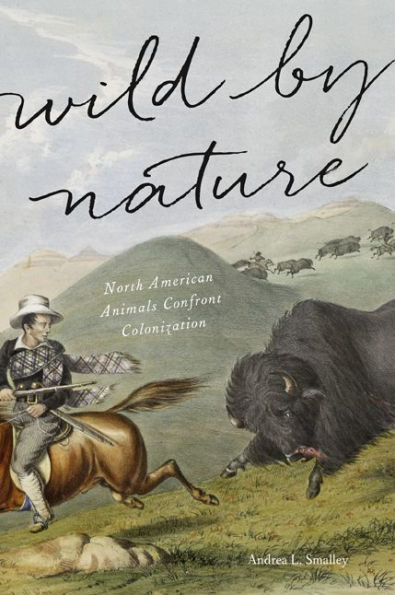Winner of the CHOICE Outstanding Academic Title of the Choice ACRL
From the time Europeans first came to the New World until the closing of the frontier, the benefits of abundant wild animals—from beavers and wolves to fish, deer, and bison—appeared as a recurring theme in colonizing discourses. Explorers, travelers, surveyors, naturalists, and other promoters routinely advertised the richness of the American faunal environment and speculated about the ways in which animals could be made to serve their colonial projects. In practice, however, American animals proved far less malleable to colonizers’ designs. Their behaviors constrained an English colonial vision of a reinvented and rationalized American landscape.
In Wild by Nature, Andrea L. Smalley argues that Anglo-American authorities’ unceasing efforts to convert indigenous beasts into colonized creatures frequently produced unsettling results that threatened colonizers’ control over the land and the people. Not simply acted upon by being commodified, harvested, and exterminated, wild animals were active subjects in the colonial story, altering its outcome in unanticipated ways. These creatures became legal actors—subjects of statutes, issues in court cases, and parties to treaties—in a centuries-long colonizing process that was reenacted on successive wild animal frontiers.
Following a trail of human–animal encounters from the seventeenth-century Chesapeake to the Civil War–era southern plains, Smalley shows how wild beasts and their human pursuers repeatedly transgressed the lines lawmakers drew to demarcate colonial sovereignty and control, confounding attempts to enclose both people and animals inside a legal frame. She also explores how, to possess the land, colonizers had to find new ways to contain animals without destroying the wildness that made those creatures valuable to English settler societies in the first place. Offering fresh perspectives on colonial, legal, environmental, and Native American history, Wild by Nature reenvisions the familiar stories of early America as animal tales.
Winner of the CHOICE Outstanding Academic Title of the Choice ACRL
From the time Europeans first came to the New World until the closing of the frontier, the benefits of abundant wild animals—from beavers and wolves to fish, deer, and bison—appeared as a recurring theme in colonizing discourses. Explorers, travelers, surveyors, naturalists, and other promoters routinely advertised the richness of the American faunal environment and speculated about the ways in which animals could be made to serve their colonial projects. In practice, however, American animals proved far less malleable to colonizers’ designs. Their behaviors constrained an English colonial vision of a reinvented and rationalized American landscape.
In Wild by Nature, Andrea L. Smalley argues that Anglo-American authorities’ unceasing efforts to convert indigenous beasts into colonized creatures frequently produced unsettling results that threatened colonizers’ control over the land and the people. Not simply acted upon by being commodified, harvested, and exterminated, wild animals were active subjects in the colonial story, altering its outcome in unanticipated ways. These creatures became legal actors—subjects of statutes, issues in court cases, and parties to treaties—in a centuries-long colonizing process that was reenacted on successive wild animal frontiers.
Following a trail of human–animal encounters from the seventeenth-century Chesapeake to the Civil War–era southern plains, Smalley shows how wild beasts and their human pursuers repeatedly transgressed the lines lawmakers drew to demarcate colonial sovereignty and control, confounding attempts to enclose both people and animals inside a legal frame. She also explores how, to possess the land, colonizers had to find new ways to contain animals without destroying the wildness that made those creatures valuable to English settler societies in the first place. Offering fresh perspectives on colonial, legal, environmental, and Native American history, Wild by Nature reenvisions the familiar stories of early America as animal tales.

Wild by Nature: North American Animals Confront Colonization
352
Wild by Nature: North American Animals Confront Colonization
352
Product Details
| ISBN-13: | 9781421422350 |
|---|---|
| Publisher: | Johns Hopkins University Press |
| Publication date: | 06/29/2017 |
| Pages: | 352 |
| Product dimensions: | 6.30(w) x 8.90(h) x 1.20(d) |
| Age Range: | 18 Years |
